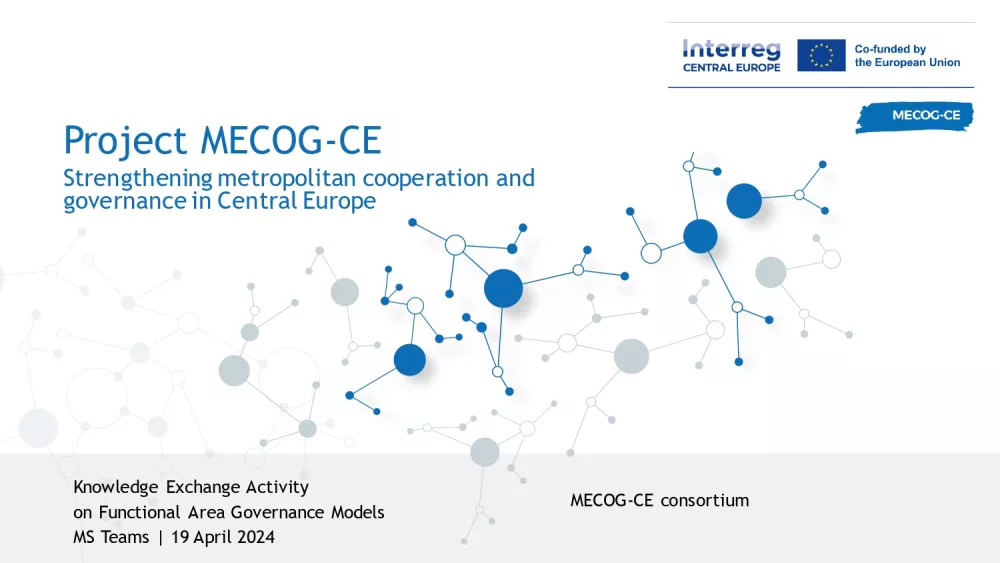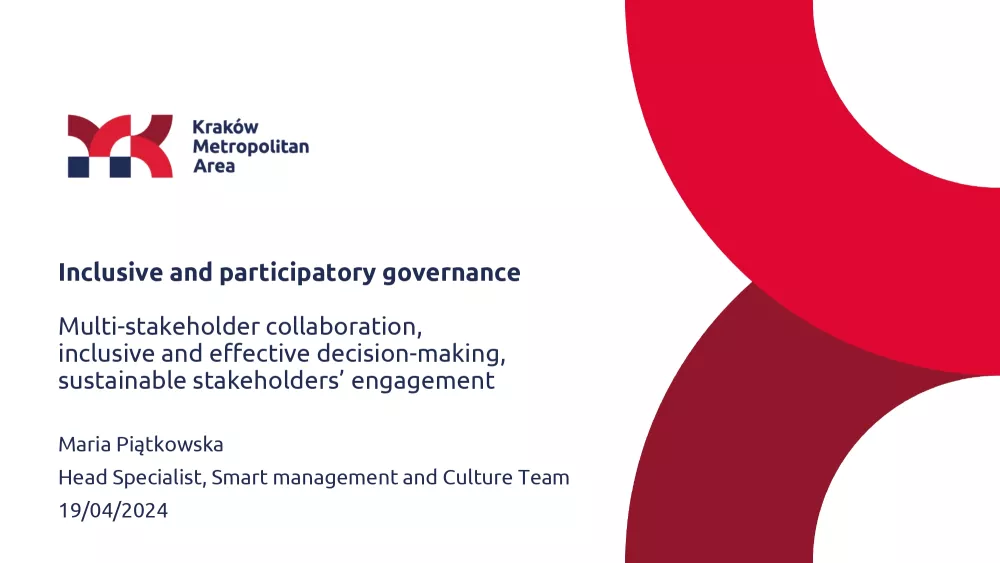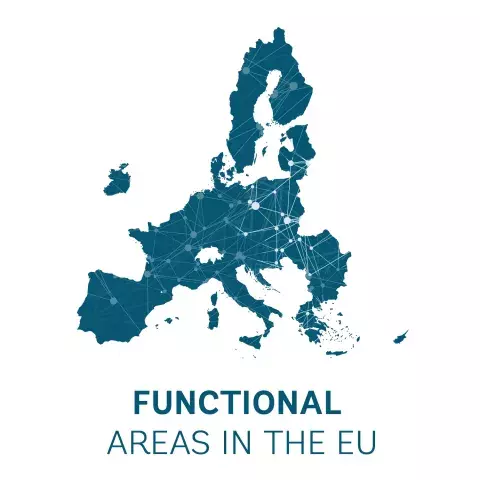Takeaways from the Knowledge Exchange Activity on Functional Area Governance Models
KNOWLEDGE EXCHANGE: FAs IN THE EU
Takeaways from the Knowledge Exchange on Functional Area Governance Models
The Knowledge Exchange Activity on Functional Area Governance Models concludes the series of KEAs organised within the Functional Areas in the EU project. The online event from April 19th was attended by 92 representatives from various functional areas.
The topic of the 12th KEA was introduced by Grzegorz Aleksander Wolszczak (Urban Development Specialist, World Bank), followed by Anna Marta Banaszczyk (Regional Development Specialist, World Bank), who emphasised the importance of effective governance to unleash the full potential of the functional area approach. Governance arrangements play a vital role in supporting the sustainability of partnerships. Meaningful involvement of diverse stakeholders at FA level supports building trust and shared ownership. However, there is no one-size-fits-all solution due to the diverse nature of functional areas and national legislative frameworks they operate in.
Soňa Raszková (Brno Metropolitan Area) presented an overview of the MECOG-CE project, focusing on strengthening metropolitan cooperation and governance in Central Europe. The 3 year Interreg project involves 9 partners across Central Europe (DE, IT, PL, CZ, HU) representing metropolitan areas, as well as academia, and runs until March 2026. The first phase of the project centred on identifying the challenges and opportunities for metropolitan areas in Central Europe and collecting best practices on metropolitan governance. The project also established study clusters on various topics and published a policy advocacy document – A Common Metropolitan Vision.
Zuzanna Neuve-Eglise (University of Silesia in Katowice) showcased the process of analysing best practices for enhancing metropolitan cooperation, based on their innovative or added value and their potential for transferability, in 14 thematic domains (transport, education, social policies, spatial planning, housing, tourism, energy etc). Many best practices are cross-cutting, showcasing the complexity of metropolitan projects, particularly under the ITI framework.
Best practices were also collected from outside the project countries, to ensure representation of diverse governance across the EU (e.g. smart management of urban parks in Barcelona Metropolitan Area, Metropolitan Table of Coexistence in Rome Metropolitan Area). The best practices are presented in story maps, and a summary, available here.
Metropolitan City of Turin – Food districts
One of the best practices mapped through the project focused on food districts in the Metropolitan City of Turin, presented by Claudia Fassero (Metropolitan City of Turin). The food districts are based on three-year plans, and once recognised, the new entities can apply for specific calls of financing. Three such food districts are currently recognised within the metropolitan area.
Stuttgart Metropolitan Area – Transport and mobility
Simone Jung (Stuttgart Region Association) presented a best practice from the Stuttgart metropolitan area. Responsible for spatial planning, transport planning and mobility, with a directly elected regional assembly the Stuttgart Region Association develops the Regional Transportation Plan (guiding traffic development) and a Regional Plan (for residential and commercial development along the railway lines). This way, the association ensures an integrated approach to spatial planning, and transit oriented development in the region.
Górnośląsko-Zagłębiowska Metropolia – GZM Metropolis) – Metropolitan Prototyping Academies
This best practice, presented by Natalia Puchała (Górnośląsko-Zagłębiowska Metropolia) focuses on cooperation between municipalities to approach a specific challenge, offering the opportunity to learn and share experience. The approach involves analysis of risks and opportunities, data collection and analysis and is highly transferable as it is not very resource-intensive.
Berlin Brandenburg – Municipal Neighbourhood Forum
The municipal forum has been running since 1996, and has 43 municipalities as members, involving also the chambers of commerce and transport association, representing 4.2 million inhabitants of the area. The forum is a bottom-up initiative, informal and voluntary, and its areas of focus are defined by the needs and interests of the municipalities. The best practice was presented by Tommi Vollman (Joint Spatial Planning Department Berlin Brandenburg).
Brno Metropolitan Area – Questionnaire among mayors
The Brno Metropolitan Area runs a questionnaire among mayors every three years to grasp the willingness to cooperate, perceptions of metropolitan issues and opportunities for joint approaches. Three such surveys were completed, and 93% of municipalities filled the questionnaire, on average, as shared by Ondřej Cmoriak (Brno Metropolitan Area).
Warsaw Metropolis Association – Joint opinions and statements, workshops and trainings
The association drafts options and statements to raise awareness on metropolitan issues and organises workshops and trainings on topics identified by members of the Association (Strategic development of the metropolitan area, saving energy and others).
A Common Metropolitan Vision – policy advocacy for metropolitan development
Within the MECOG-CE project, a policy advocacy document was developed to articulate a joint vision for metropolitan areas, which was first presented publicly within this KEA. Luděk Sýkora (Charles University, Prague) highlighted the favourable EU policies (New Leipzig Charter, Territorial Agenda 2030 and instruments – ITI), and the importance of participation in knowledge sharing events and networks and policy advocacy.
A first observation was that metropolitan dimension requires a more explicit narrative in European and strategic documents, as metropolitan development is approached rather rarely, fragmentarily, and secondarily to urban development. An online survey provided inputs related to the metropolitan cooperation and governance needs, benefits or advantages of the metropolitan dimension, which were reflected in the formulation of the metropolitan vision.
The key objective of the Common Metropolitan Vision is prompting a durable commitment of leaders and other stakeholders, to maximise the positive impacts of metropolitan areas to the overall prosperity and quality of life in Europe.
The advocacy document is organised around 3 components: the future state of metropolitan areas, metropolitan strengths and commitments, and metropolitan empowerment. It envisages metropolitan areas as centres of everyday life and creativity that are balanced, inclusive and sustainable. Metropolitan areas are also diverse and complex communities and involve a metropolitan partnership and identity.
Insights from Krakow Metropolitan Area
In the last session of the knowledge exchange, Maria Piątkowska (Krakow Metropolitan Area) showcased key insights from the experience of the KMA. While initially the ITI was perceived as a tool to attract funds, the cooperation was significantly expanded beyond the implementation of the ITI. The aim of the KMA is not to replace local governments or become another level of government, but to strengthen governance and increase the impact of implemented tasks and projects. The association is consensus-driven – from 2021, the association requires unanimity in the presence of at least half of its members. Consensus-seeking is one of the guiding principles of KMA cooperation.
The KMA is funded from membership fees, national and international projects, and EU funds (ITI). A major part of its funding -in line with strategic objectives determined in the KMA’s supralocal strategy 2030 – is allocated to environment and space and mobility, followed by social services, education, leisure, economy, and smart governance.
The main avenues identified for improving the governance and legitimacy of metropolitan areas in Poland are strengthening institutions at the supra-local level, financially rewarding partnership projects within functional urban areas areas, and creating a legal framework to support co-creation in functional urban areas. Solutions that were successfully applied in KMA and are transferrable to other functional areas include: elaborating a supra-local strategy to define and agree on shared development objectives, involving mayors and selected municipal staff in thematic committees to exchange knowledge and work together on solutions, and agreeing on a fixed schedule of meetings to streamline cooperation.
Finally, Grzegorz Aleksander Wolszczak (Senior Urban Development Specialist, World Bank) also shared the ongoing initiative of establishing a REGIO Peer2Peer community of functional areas, responding to the need for continuous learning and exchange of experience and best practices in cooperation across administrative boundaries.
We thank all attendants to our Knowledge Exchange Activities organised over the past two years, which helped build the first community of functional areas in the EU and invite you to keep connected across all channels!
Find out more:
MECOG-CE project: https://www.interreg-central.eu/projects/mecog-ce/
Best practices in metropolitan governance – Story maps:https://storymaps.arcgis.com/stories/6c9f00d17d7c4f33a15d77f22254f196
The Knowledge Exchange Presentations:
About this resource
In 2021, the European Commission launched a pilot project to improve functional area approaches in the EU and has partnered with the World Bank to implement this initiative. As part of the project, the project team collaborated with 12 functional areas from seven EU countries, providing them with tailored technical support and assistance: Zagreb Urban Agglomeration (Croatia), Brno Metropolitan Area (Czech Republic), West Athens (Greece), Lake Balaton Area (Hungary), Kalisz-Ostrów Agglomeration, Kraków Metropolitan Area (Poland), Jiu Valley and Jiu Conurbation Functional Area, Caraș-Timiș Functional Area, Cluj Metropolitan Area, Oradea Metropolitan Area, West Ialomița Functional Area (Romania), and Trenčín Functional Area (Slovakia).
Similar content






